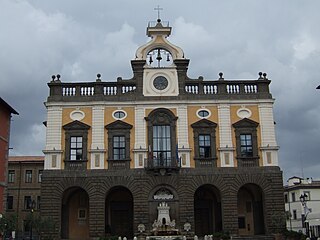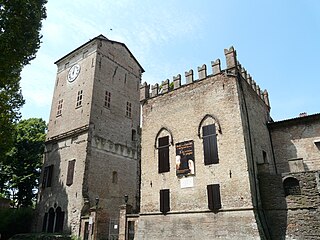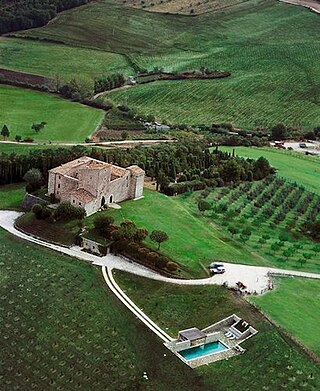
Cesare Borgia was a Spanish-Italian cardinal and condottiero, an illegitimate son of Pope Alexander VI and member of the Spanish-Aragonese House of Borgia. His fight for power was a major inspiration for The Prince by Niccolò Machiavelli.

Lucrezia Borgia was an Italian noblewoman of the House of Borgia who was the illegitimate daughter of Pope Alexander VI and Vannozza dei Cattanei. She reigned as the governor of Spoleto, a position usually held by cardinals, in her own right.

The House of Borgia was a Spanish noble family, which rose to prominence during the Italian Renaissance. They were from Xàtiva, Kingdom of Valencia, the surname being a toponymic from the town of Borja, then in the Crown of Aragon, in Spain.

GiacomoBarozzida Vignola, often simply called Vignola, was one of the great Italian architects of 16th century Mannerism. His two great masterpieces are the Villa Farnese at Caprarola and the Jesuits' Church of the Gesù in Rome. The three architects who spread the Italian Renaissance style throughout Western Europe are Vignola, Serlio and Palladio. He is often considered the most important architect in Rome in the Mannerist era.

Nepi is a town and comune in the province of Viterbo, Lazio, central Italy. The town lies 30 kilometres (19 mi) southeast of the city of Viterbo and about 13 kilometres (8 mi) southwest from Civita Castellana.

Meldola is a town and comune near Forlì, in Emilia-Romagna, Italy.

Rocca Priora is a small town and comune in the Metropolitan City of Rome, Lazio, Italy. It is one of the Castelli Romani on the Alban Hills about 25 kilometres (16 mi) southeast of Rome, situated in the Regional Park known as the "Parco Regionale dei Castelli Romani".

Barge is a comune (municipality) in the Province of Cuneo in the Italian region Piedmont, located about 50 kilometres (31 mi) southwest of Turin and about 45 kilometres (28 mi) northwest of Cuneo. The population numbered 7,589 as of 30 November 2019.

The Castelli di Cannero are three rocky islets of Lake Maggiore in northern Italy. They are located off the shoreline of Cannero Riviera while administratively forming part of the Comune of Cannobio. They are known as castelli, or castles, in recognition of the ruined ancient fortifications which are found on two of them. They are all that remains of the Rocca Vitaliana fortress built between 1519 and 1521 by Ludovico Borromeo, who gave it this name in honour of an illustrious ancestor.

Rocca dei Rossi is a castle located at piazza Mazzini #12 in the town of San Secondo Parmense, province of Parma, in the Italian region Emilia-Romagna. A different Rocca dei Rossi, also known as Castello di Roccabianca, is located in the town of Roccabianca.

The Todi Castle is a former medieval Castle located 15 km south of the town of Todi, to the east side of the town of Collelungo, which is part of the Municipality of Baschi, near Terni, in Umbria, Italy.

Maria Villavecchia Bellonci was an Italian writer, historian and journalist, known especially for her biography of Lucrezia Borgia. She and Guido Alberti established the Strega Prize in 1947.

Mategriffon or Matagrifone or Mathegriffon or Rocca Guelfonia was a medieval castle in Messina, Sicily, located in what is today Viale Principe Umberto. Its strategic position upon a rocky hill close to the historic city centre gave a commanding view of the harbour and Strait of Messina. In the 19th century it was converted into a prison. Prior to its destruction in the 1908 earthquake it comprised a square dungeon with ramparts and reinforced by polygonal towers. Only an octagonal tower remains standing and is incorporated into the 20th century Shrine of Christ the King church, a visible Messina landmark which dominates its skyline.

Sismano, a little medieval borgo, is a frazione of the Italian commune of Avigliano Umbro, in the province of Terni. Sismano lies 13 km from Todi and 5 km from Avigliano; according to the Italian state census of 2001, Sismano has 17 inhabitants in the densely built historic center and 308 in all.

The Rocca dei Borgia is a 16th-century castle in Camerino, in Marche, Italy originally built for Cesare Borgia.

The Rocca Abbaziale is an abbey, designed as a castle, in Subiaco, Lazio, Italy.
A number of Italian castles are associated with the Borgia family of Pope Alexander VI including:

The Visconti Castle of Vogogna is a medieval stone-made castle in Vogogna, Piedmont, Northern Italy. It was built in the 14th century by the Visconti, lords and dukes of Milan.

The Visconti Rocca of Urgnano, also known as Visconti Castle or Albani Rocca, is a middle age fortification in Urgnano, Lombardy in northern Italy. It was built in 1354 by Giovanni Visconti, Archbishop, and Lord of Milan. Today, it is the property of the Urgnano municipality.


















